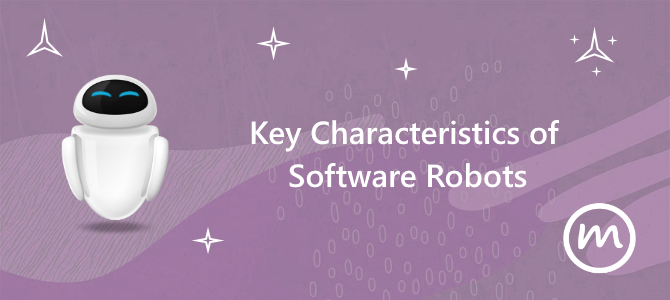5 key characteristics of software robots in Process Automation

RPA tools have strong technical similarities to GUI based testing tools as these tools also automate interactions with the GUI, and often do so by repeating a set of repeated actions performed by a user. RPA tools differ from such tools in features like – it allows data to be handled across multiple applications. For e.g. receiving email containing an invoice, extracting the data, and then typing that into a accounting system.
Key characteristics of software robots include:
Key characteristics of software robots include:
Workflow driven software, no code (or) less programming required
Programs imitating human interaction with applications (User friendly)
Cross-functional application
Virtual workforce controlled by business operations
Agile and non-invasive, works with existing IT architecture and governance
In other dimension the following characteristics are still significant:
- Humans are still important – Even with the influx of robots, many robotic process automation (RPA) firms are still continuing to rely on humans. That means humans are still involved in the loop. Several RPA product companies are exploring how humans and robots can seamlessly work together through case management and analytics. There’s still some work to be done in many areas and that’s currently in progress.
- Plug and Play – Services are still a key in the IT space and such characteristics extend into the RPA space. According to Forrester, some product companies have eased the robotic management process through the development of plug and play systems that can be run by non-programmers while also connecting with third-party application integration.
- Catching the low-hanging fruit – Sometimes keeping things simple is all that matters. For some RPA firms, that’s what their offerings are all about, either offering individual robots or robots that run on the side with the possibility of expansion and scalability. In fact, RPA became increasingly popular just because of this one characteristic. For organizations seeking quick wins, having this service on the market is helpful.
Benefits of RPA
Some of the key benefits of RPA are as follows:
- Cost: A software robot costs much less than a human worker and each does the work of 3-5 FTEs
- Speed: 4 x the processing speed. Works 24 x 7 / 365
- Quality: 100% accuracy: no human errors, no rework
- Human effort shifted to value adding tasks that involve interaction, judgment and interpretation - improved job satisfaction; new value
- Faster deployment of new services – fast automation of processes and rapid integration of front-end digital technologies with back office legacy environments: a potential lifesaver for incumbents struggling to keep pace with new rivals
- Increased operational agility – robots can scale up and down and switch their tasks according to demand. If requirements change, a robot can be trained quickly to adapt, without the constraint of business silo or human resource issues and associated training costs
- Improved compliance - especially in highly-regulated industries. RPA improves control by providing consistent adherence to set rules. All tasks are tracked and monitored to aid compliance evidencing and audit trails
- Improved customer experience – faster service delivery; 24 hour coverage; staff freed-up for customer-facing roles
- Provides insight – RPA makes gathering and organising data easier so a company can predict future outcomes and optimise their processes
- Flexible Workforce – robots don’t go sick, require performance reviews or compensation increases and don’t depart for jobs with competitors